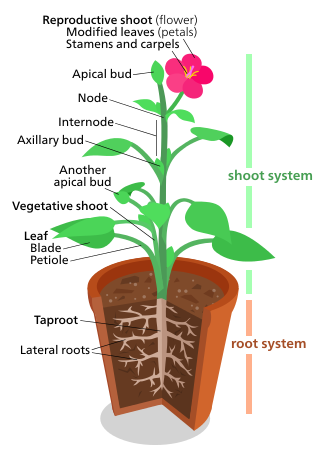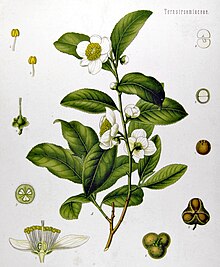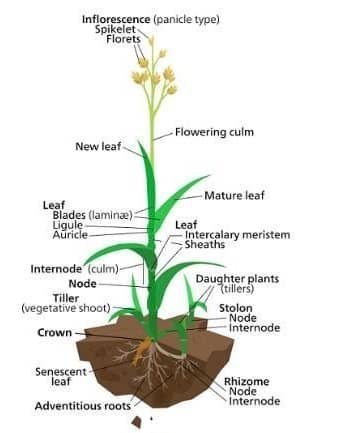
What is External Morphology of Plants?
Morphology deals with the forms and features of different plant organs such as roots, stems, leaves, flowers, seeds, and fruits.
The study of life external structures of organs is otherwise known as external morphology. All the morphological parts have their specific features which provide immense information regarding, authenticity or otherwise adulteration.

External Morphology of Tea (Camellia sinensis)
- Family: Theaceae
- Habit: Small evergreen tree up to 1 5m-in height 5-1.5 m in cultivation.
- Root: Taproot system lateral root as surface mate feeding root Alternate, evergreen, obovate, lanceolate, acuminate. leathery, upper surface glossy.
- Leaf: serrate, 3-3- cm long, larger in the early stage of growth and after pruning.
- Inflorescence: Solitary-axillary or in a cluster of 2-4.
- Flower: Complete hypogynous, self-incompatible(bracteate).
- Calyx: Sepal 5-7, persistent, unequal.
- Corolla: Petals 5-7, white or tinged pink, obovate, concave.
- Androecium: Stamens numerous, Monadelphous, adnate to the base of petals.
- Gynoecium: Ovary superior, Carpels 3-5, 4-6 ovule per carpel pendulous, style short.
- Fruit: Capsule, seed usually solitary- in each cell.
- Floral formula:
External Morphology of Rice (Oryza sativa)
- Family: Gramineae
- Habit: annual cultivated filleting herb.
- Root: Fibrous and adventitious root system.
- Leaf: Simple, alternate, sessile, divided into leaf blade and leaf sheath, the leaf blade is linear, entire acute, pubescent with parallel venation, membranous, long, and the triangular ligule is present on the junction of the leaf blade and leaf sheath. terminal leaf (flag leaf) encloses the panicle.
- Inflorescence: Panicle of spikelet.
- Spikelet: leathery, compressed, and pedicellate. each spikelet includes 2 empty glumes, a minute rachilla, and a floret.
- Flower: Minute. sessile, bracteate, incomplete, bisexual, zygomorphic, Irregular, hypogynous.
- Perianth: The perianth is represented by two broad, thick, fleshy, and transparent lodicules.
- Androecium: Stamen 6 in 2 alternating whorls, polyandrous, filament short, and slender. anther long, two-lobed and versatile.
- Gynoecium: Monocarpellary, ovary superior and unilocular, stigma bifurcated and plumose, style short, placentation basal.
- Fruit: Caryopsis
- Floral formula:

External Morphology of Wheat (Triticum aestivum)
- Family: Gramineae
- Habit: A cultivated winter herb.
- Root: Fibrous and adventitious. Stem: Simple, erect, herbaceous, cylindrical with 5-7 solid nodes and hollow internodes.
- Leaf: Simple, iso-bilateral, and divided into leaf sheath and leaf blade. A two clamp-shaped hairy- auricles present at both ends of the junction of leaf sheath and leaf blade. Leaf-blade is thin, lanceolate, entire acute, and hairy with parallel venation. terminal leaf (flag leg encloses the inflorescence.
- Inflorescence: Spike of spikelets.
- Spikelet: Sessile, borne on unbranched and zigzagged rachis arranged in two rows with a single terminal spikelet. It is composed of a minute rachilla, a variable number of florets (3-7), and boat-shaped two empty glumes.
- Flower: Incomplete, Minute, sessile, bracteate, bisexual or hermaphrodite or perfect, zygomorphic, irregular, and hypogynous.
- Perianth: It is represented by two broad, thick, fleshy, and transparent lodicules, lie beneath the ovary.
- Androecium: Stamen 3, polyandrous, filament short and slender, anther large, diecious(2-lobed), and versatile
- Gynoecium: Monocarpellary, ovary superior and unilocular, stigma bi-furcated, style reduced; and placentation basal.
- Fruit: Caryopsis
- Floral formula:

External Morphology of Jute (Corchorus capsularis-white)
- Family: Tiliaceae
- Habit: An annual cultivated herb
- Root: Taproot system (numerous branches developed), in case of C. capsularis adventitious root developed.
- Stem: Herbaceous, erects cylindrical. solid, slender, smooth at the top but rough at the base, branching near the top, green in color, mucilaginous.
- Leaf: Simple, alternate, deciduous, petiolate, petiole long, margin serrate, auriculate, lower two serrations prolonged into fine pointed auricles, apex acuminate, venation reticulate.
- Inflorescence: Solitary or few-flowered cymes, opposite to leaves.
- Flower: Complete, pedicellate, bracteate, small, bisexual, (dichlamydeous, actinomorphic,) regular, (pentamerous, hypogynous yellow in color.
- Calyx: Sepal-5, polysepalous, narrow, green in color, aestivation velvet.
- Corolla: Petal-5, polypetalous, aestivation- imbricate.
- Androecium: Stamen many, polyandrous, filament long and thin, anther small, kidney-shaped, 2- lobed.
- Gynoecium: Carpels-5, syncarpous, ovary superior, 5-locular with numerous ovules, style short, capitate stigma, placentation axile.
- Fruit: Capsule
- Floral formula:

External Morphology of Sugarcane (Saccharum officinarum)
- Family: Gramineae
- Habit: Sugarcane is a tall grass that looks rather like a bamboo cane. Some form up to 6 meters tall.
- Root: Two kinds of roots will develop from a planted seed. The set roots, which arise from the root band, are thin and highly branched; the shoot roots, originating from the lower root bands of the shoots, are thick, flesh and less branched
- Leaf: The leaf of the sugarcane plant is divided into two parts: sheath and blade separated by a blade joint. The leaves are usually attached alternately to the nodes, thus forming two ranks on opposite sides. The mature sugarcane plant has an average total upper leaf surface of about 0.5 square meters and the number of green leaves per stalk is around ten, depending on variety and growing conditions.
- Inflorescence: The inflorescence, or tassel, of sugarcane, is an open-branched panicle. It is known as an arrow (spike of spikelet). Each spikelet is surrounded at the base by a ring of long callus hairs and contains two flowers- one is sterile and the upper one bisexual.
- Stalk: The stalk consists of segments called joints. Each joint is made up of a node and an internode. The node is where the leaf attaches to the stalk and where the buds and root primordia are found. In general, the joints at the base are short and inter-nodal length gradually increases. The outer small leaves are in the form of scales. The outermost bud scale has the form of a hood. Normally, one bud is present on each node, and the alternate between one side of the stalk to the other.
- Androecium: Stamen 3, anther bilobed and versatile.
- Gynoecium: 2 terminal styles, each ending with feathery stigma. The ovary contains a single ovule.
- Fruit: Caryopsis. Floral formula:
- Mustard (Brassica campestris)
- Family: Cruciferae
- Habit: A cultivated annual herb.
- Root: Taproots system.
- Leaf: Simple, exstipulate, alternate, cauline, radical leaves are lyrate and petiolate, upper leaves are sessile oblong, amplexicaul, margin lobed, surface hairy, venation reticulate.
- Inflorescence: Terminal raceme
- Flower: Complete, bisexual, actinomorphic, regular, pedicellate, small, ebracteate, cruciform, tetramerous; hypogynous, yellow in color.
- Calyx: 4-Sepal (two whorls), polypetalous, lanceolate, aestivation- imbricate.
- Corolla: 4- petals (one whorls), cruciform, aestivation- velvate.
- Androecium: 6-stamens (two whorls), nectaries at the base of long stamens, filament short, anther basifixed and bilobed.
- Gynoecium: 2-carpels, syncarpous, ovary superior, style short, stigma bilobed, placentation-parietal.
- Fruit: Siliqua
- Floral formula:






No comments:
Post a Comment